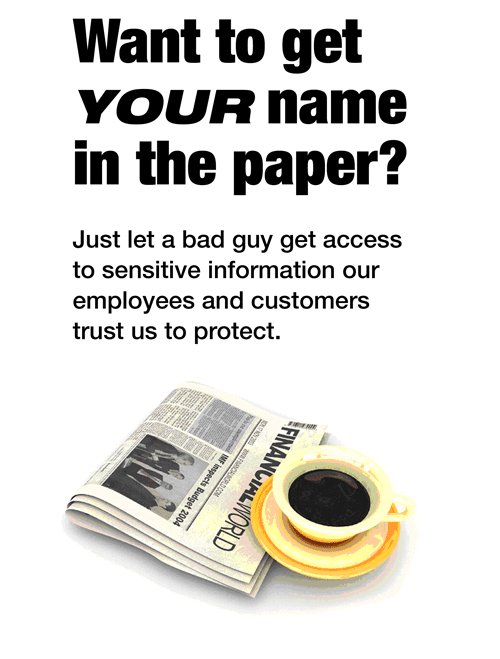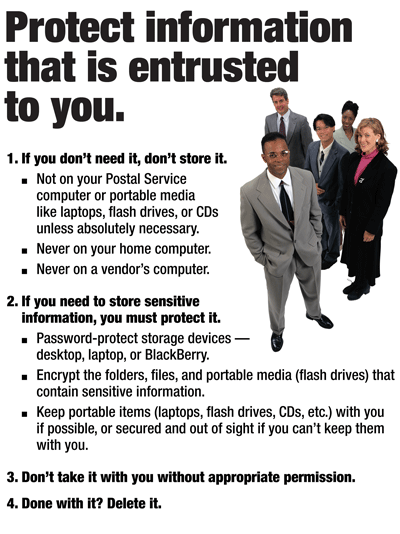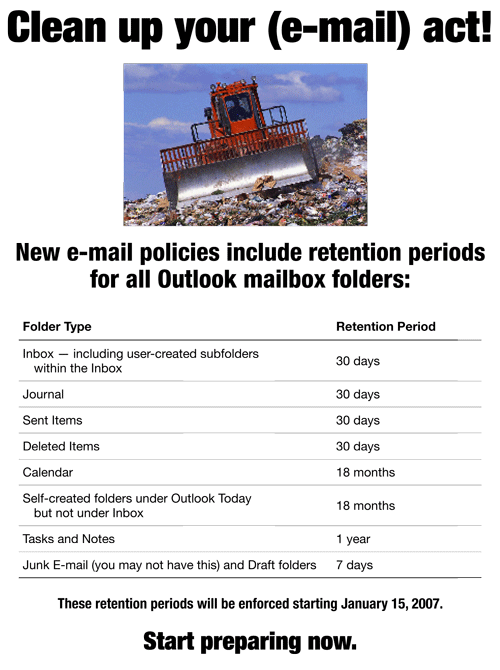|
NOTICE
Data Protection Tips, Tools, and Requirements
Revisions to Handbook AS 805, Information Security,
published on pages 14-20 of this issue and in Postal
Bulletin 22190 (9-28-06, pages 30-34) emphasize YOUR
responsibility for protecting sensitive information when it is
entrusted to you. Below are suggestions for complying with
these revisions.
What is Sensitive Information?
Sensitive information includes full Social Security numbers; Postal ServiceTM applicant or employee medical information; fingerprints; personnel records; phone
numbers; driver's license numbers; credit card information;
and birth date, age, or buying habits when associated with
a person's name or other personal identifier. For more examples of sensitive information, go to http://www.usps.com/privacyoffice/_pdf/AS805ABIA383.pdf. See page 22 of the
document (page A-9 of Appendix A).
Do not put sensitive data onto any device, including
your own workstation, unless it is absolutely necessary
for the conduct of your business and you have permission
to do so. Remember, when you possess such data, you assume the responsibility of protecting it from theft or other
disclosure.
Do encrypt files containing sensitive personal or
business information stored on your workstation, portable media, or sent via e-mail.
• To store sensitive files on your workstation or send
them via e-mail, encrypt them using WinZIP. For
step-by-step instructions on encrypting files or sending encrypted files in e-mail, go to http://ithelp. Click
on Find Answers. Enter Encrypt in the Search Text
box, then click the Search button. Click on the topic of
interest to you.
• To store sensitive data on portable media, use an encrypted flash drive, and always use it in encrypted
mode. Kingston's DataTraveler Elite - Privacy Edition flash drives are available from the ADEPT II catalog via eBUY. They are now the Postal Service
standard for portable media.
• CLIN 733-A04: 1GB Secure USB 2.0 Flash Drive
Postal Service price: $80 each
• CLIN 733-B04: 2GB Secure USB 2.0 Flash Drive
Postal Service price: $133 each
When you insert the flash drive into a desktop or laptop,
you will be prompted to create a password. Then, whenever the flash drive is inserted again, you will need to use the
password to access the files stored on the flash drive.
Do not store Postal Service information on non-
Postal Service-owned devices. These include contractor, vendor, and personal computers.
Do not remove sensitive Postal Service information
from Postal Service premises without approval from
your functional area vice president and the Chief Information Officer. The Chief Information Officer is the Chief
Technology Officer. An e-mail trail showing appropriate approvals, the nature of the information, the reason for removal from Postal Service premises, and the type of device on
which it is stored (i.e., laptop, flash drive) is sufficient.
Do immediately report lost or missing devices on
which sensitive information is stored. Cut out the wallet
card below and carry it with you.
Do protect portable devices at all times, even if they
are encrypted. At work, secure laptops and thumb drives
in a safe place. When you are traveling, keep them with you
or locked in a room safe. Do not leave them in a vehicle -
not even a locked vehicle.
Remember: If you don't need it, don't keep it. If you keep
it, protect it! And if you take sensitive information from
Postal Service premises, get approval first.
— Technology Planning, Policy, and Communications,
Information Technology, 11-23-06

D-LINK


D-Link
NOTICE
New Retention Periods for Outlook E-mail
On January 15, 2007, Information Technology will begin
enforcing new rules for retaining Outlook e-mail messages.
Five years ago the Postal ServiceTM averaged 3 million e-mail transactions daily. Now, the number is 9.3 million, a
300 percent increase. The increased volume has depleted
e-mail storage and strained the entire system. A new management instruction (MI), AS-870-2007-1, Electronic Messaging, establishes retention periods for all files and folders
in your Outlook mailbox and explains the new policy. The
MI will be published before the end of this year.
The new retention periods will reduce e-mail storage by
75 percent, which will reduce storage costs, allow faster
backups and restorations, improve performance for the entire e-mail system, and automate mailbox cleanup. Also,
because of new "E-Discovery" rules which become effective December 1, the Postal Service must be able to index
all of its e-mails and other electronic documents. This process is costly and time consuming. The more e-mails
stored, the longer the process will take and the more it will
cost.
|
Folder Type
|
Retention Period
|
|
Inbox - including user-created subfolders
within the Inbox
|
30 days
|
|
Journal
|
30 days
|
|
Sent Items
|
30 days
|
|
Deleted Items
|
30 days
|
|
Calendar
|
18 months
|
|
Self-created folders under Outlook Today
but not under Inbox
|
18 months
|
|
Tasks and Notes
|
1 year
|
|
Junk E-mail (you may not have this) and
Draft folders
|
7 days
|
Start now to delete unneeded messages, move those
you must keep out of your Inbox, and develop a schedule
for reviewing items in your Inbox. Information Technology
will automatically enforce these retention periods beginning
January 15, 2007.
The goal is to ELIMINATE - not move - unneeded
files. If you must keep certain files, archive them to your
hard drive, move them to My Documents, or move them to
portable media such as CDs or flash drives. Be sure to secure information, particularly information stored on portable
media. See the article "Notice: Data Protection Tips, Tools,
and Requirements" on pages 20-21 and 23 of this issue.
Deleting E-mails
You can identify a block of e-mails to delete but first you
will want to sort the messages. Here are some options:
• Select a column heading of your choice: From, Subject, Date, or Size. If you want to reverse the order,
select the column heading again.
As an example, if you sort your messages using
From, you can then choose a message from John Q.
Doe by starting to type his last name, and all messages from him will come to the top of your Inbox
screen. Type fast, or the process will begin without
you.
If you haven't sorted by name but are looking at a
message from John Q. Doe, highlight his message,
select From at the top, and you will get all his
messages.
• Sort your messages by selecting View, then Current
View, then select a view option.
• Find e-mails using a name or a word in the subject or
in the body of the message. Go to Tools and select
Find. In the box that appears, type in your search
term, choose where to search, and select Find Now.
All related messages will appear.
Note: Select Options to the right of your screen to
choose whether you want ALL text searched.
• Select Tools, then Mailbox Cleanup. Search for e-mails by size or age. Select either Edit or Select All,
or select the items you want to delete. Select Edit
again, then Delete.
To select and delete a block of e-mails:
1. Highlight the first item you want to delete.
2. Hold down the Shift key and highlight the last item in
the block you want to delete.
3. Delete by pressing the Delete key on your keyboard,
by selecting the Delete icon if it is displayed on your
toolbar, or by selecting Edit, then Delete.
To select and delete specific e-mails:
1. Highlight the first item you want to delete.
2. Hold down the Ctrl key and highlight each item you
want to delete.
3. Delete by pressing the Delete key on your keyboard,
selecting the Delete icon if it is displayed on your toolbar, or by selecting Edit, then Delete.
You can combine these two options by selecting a block
of items using the Shift key and using the Ctrl key to deselect items you don't want to delete.
Remember, nothing is REALLY deleted until it is removed from the Deleted Items folder. Remove deleted files
by right clicking on Deleted Items, then Empty Deleted
Items. Keep in mind that the Deleted Items folder is automatically purged after 30 days.
Saving e-mails
The goal of this new policy is to eliminate - not
archive - Outlook files. If you must keep files beyond
their retention period, you have some options:
Archive the files to your hard drive. You can save the
messages you need to keep by creating and using archive
folders. Here's how:
1. In Outlook, select File then Data File Management,
then Add.
2. In the New Outlook Data File box, select OK. Create
a file name and select OK again.
3. In Create Microsoft Personal Folders, enter the name
(generally the same as your file name). Select OK.
The new file will appear in the Outlook Data Files
box. Select Close.
4. In Outlook, go to View and select Folder List. The file
created will appear at the bottom.
5. Now you can create subfolders and move your messages to those folders.
These folders and files will be saved on your local (C:)
drive, so you will need to back them up in case of problems
with your hard disk. You should also review them regularly
and delete any items you no longer need.
Remember that an archive .pst file will become corrupted when it reaches 1.8 gigabytes. You should check the
archive. pst file regularly to see if you need to reduce the
size by deleting or moving items. You can do this as follows:
1. Go to the Outlook folder list.
2. Right click on the PST file and select Properties.
3. Select the folder size.
Save the file(s) to My Documents. You can save e-mails just as you would Word, PowerPoint, or Excel files.
With the message open, go to File and select Save As.
Select My Documents, then the folder in which you would
like to save the message. Hint: You can save the message
using the same name as the subject line or rename it to
your liking.
Save the file(s) to a disk or flash drive. To save Outlook files, you must first save them as personal folder (.pst)
files:
1. Select File in the main menu, then Import and Export.
The Import and Export Wizard opens to walk you
through the process.
2. Select Export to a file from the option list and then
click Next.
3. At Create a File of Type, select Personal Folder File
(.pst) and click Next.
4. The next window is Export Personal Folders. You will
get a prompt, Select the folder to export from:. If you
have subfolders in your Personal Folders that you
also want to copy, be sure to select the Include Subfolder checkbox. Click Next when you have completed your selections.
5. Select the destination for your exported file by selecting Browse. In order to write the file to a CD, you
must first create the file in your file system, such as
My Documents, and copy it to the CD.
6. Once you have selected the destination, click Finish.
Your personal folder is now ready to be copied to a CD
or flash drive, just as you would copy a Word document or
Excel file. Find the file in your system, right-click on the file,
and select Send To. From the shortcut menu, choose the
destination drive.
Note: These are Outlook Data Files and can only be
opened using the Open, Outlook Data File option under File
on Outlook's main screen.
Caution!
Saving files can be efficient and convenient but may
pose a security risk and defeat the purpose of retention periods - eliminating unneeded information. Select carefully the e-mails you copy to disk. Remember, you must
encrypt sensitive information and get approval from your
functional area vice president and the Chief Technology
Officer before removing Postal Service information
from Postal Service premises. See the article "Notice:
Data Protection Tips, Tools, and Requirements" on pages20-21 and 23 of this issue.
Watch for more information in the coming weeks.
—Information Technology Service Center,
Information Technology, 11-23-06

| 